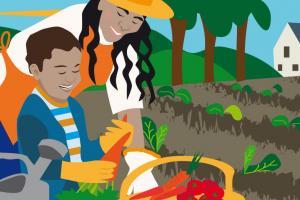8 Plants To Make Your Garden More Bee-Friendly
If we think of our life as a garden, what would it be like without bees? A lonely one. As well as our life, a garden not only needs to be fertilised and watered quite often but it also needs to be populated by friends. It is said: “gardening adds years to your life and life to your years”, so why not to share that intense joy of kneeling in the mud and pulling out weeds together with those little pollinators?
Dave Goulson, Professor of Biology at Sussex University, author of the new Sunday Times Bestseller ‘The Garden Jungle‘ argues that gardens could become places where we can reconnect with nature and rediscover where food comes from. With just a few small changes, our gardens could become a vast network of tiny nature reserves, where humans and wildlife can thrive together in harmony rather than conflict. Ultimately, he explains how our lives and the fate of humankind are inextricably intertwined with that of earwigs, bees, lacewings and hoverflies, unappreciated heroes of the natural world.
We’ve lost sight of the fact we’re part of nature and gardens are a great place to reconnect with it, even in a city a small garden can be full of life.
Next time you visit a garden centre, think like a bee
Whether you have a window box or large garden, planting bee-friendly flowers can help boost your local bumblebee population. In return, they will dutifully pollinate our flowers, crops, fruits and vegetables.
Next time you visit a garden centre, go for more ‘open’ plants. According to the Royal Horticultural Society (RHS), the best ways to encourage bees and other pollinators into our green areas are:
- Provide nectar and pollen-rich flowers throughout the year
- Avoid using pesticides wherever possible and never spray open flowers
- Create suitable nest sites in our garden
8 Bee Friendly Flowers
The UK’s largest independent online florist, Serenata Flowers, has compiled a list of eight flowers that you can plant to attract bees and make your green space pollinator-friendly.
Crocus
These tiny flowers are often one of the first to push through the snow each year, as spring arrives, and are a fantastic source of food for bees during the colder months of early spring. Honeybees mix the fresh pollen with honey to create bee bread which they then take back to the hive to feed the colony.
Lavender
We’re not the only creatures that enjoy the pretty purple colour and relaxing scent of lavender – bees have been found to love it too. Create a window box display centred around lavender to attract pollinators and as a bonus, you’ll get a refreshing burst of scent every time you open the window. This hearty plant should return to flower each year and is incredibly low maintenance.
Sunflowers
These dramatic flowers are a timeless classic and will add an iconic look to your garden whilst creating a feast for the local bees. Sunflowers can grow to enormous heights and act as a beacon for buzzing bees who can’t get enough of their delicious nectar and pollen. What’s more, once the flower is finished blooming you can save the seeds for planting later or add some to your dinner.
Zinnias
Zinnias are a honeybee’s favourite food. Low to the ground and often found in an abundance of colourful wide petalled buds, these flowers are sure to attract bees to your garden. Blooming in the late summer and early autumn these pretty flowers will add some delightful colour to your garden in the late season and keep the bees returning for months.
Echinacea
Offering a huge landing pad these flowers attract bees in their dozens and unlike many flowers, this pretty species keeps producing large quantities of nectar all through the day. The bright colours add an extra attraction for our buzzing friends and will keep your garden looking vibrant. These plants can survive very cold winters making them the ideal bee attractor for a British garden.
Iris
Other excellent choices for a bee-friendly environment are irises. Their beautiful purple and white colouring help them stand out against foliage and attract bees. These pretty little flowers can flourish in shallow soil and even in light shade, making them the ideal balcony plants or perfect for gardens that have limited hours of sunlight, such as gardens in built-up areas.
Rosemary
Some may be surprised to learn that before it ends up on the shelf in supermarkets this popular herb grows small purple blooms, which bees can’t get enough of. This delicious smelling plant makes a great addition to window boxes, so those with even the smallest amount of space can do their part to help the bees. As it flowers all year round this lovely little plant provides a great snack for bees throughout the year.
Apple Blossom
If you are lucky enough to have an apple tree in your garden, you may want to spend some time observing which insects stop by for a visit whilst it’s in bloom – you might be in the presence of royalty. Apple Blossom is the favourite flower of queen bees, the bees responsible for laying eggs and keeping the population thriving. Enjoy the spring months trying to spot the royal visitor as she stops for her lunch.




